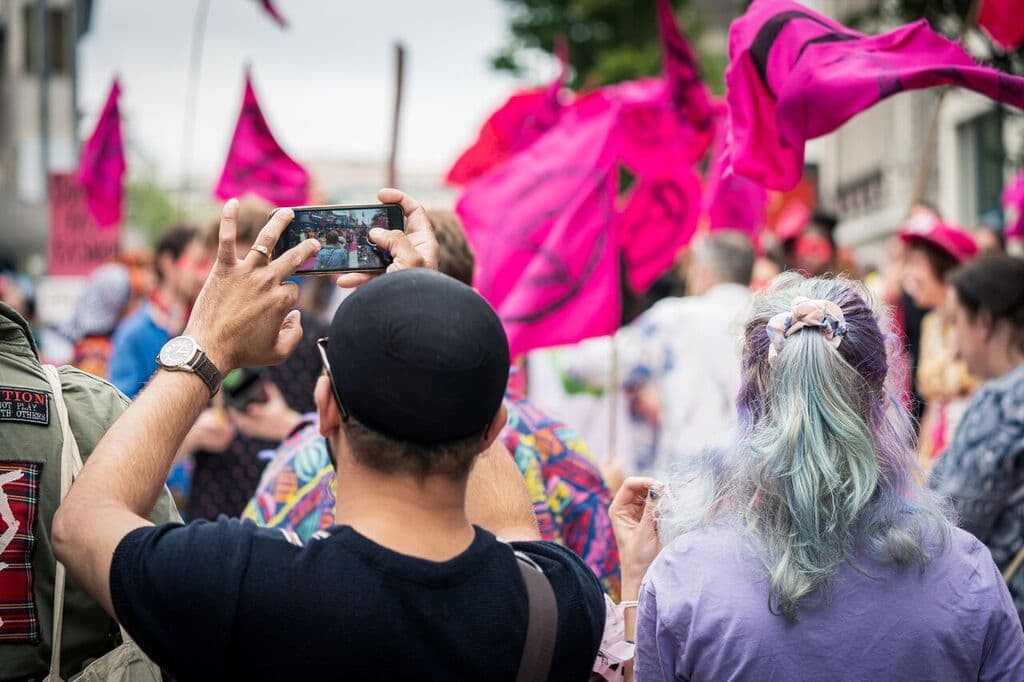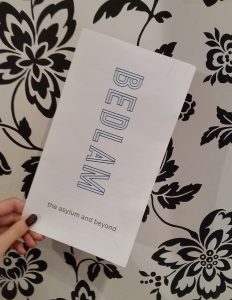[Photo shows me, holding a pink flag with an XR logo in front of a crowd at Bluedot]
When I first heard of Extinction Rebellion (XR) in February 2019, it instantly caught my attention. A bold organisation demanding radical change, with a decentralised structure and clear aims I believed in: I got stuck right in. Climate action, which I would soon come to term ‘climate justice’, has been an issue for me which I have been passionate about for a number of years, but through XR and XR Youth (XRY) I finally felt able to make a more impactful difference beyond my own individual consumer or dietary habits. This blog will assume a link between inequality, exploitation and the need for extensive structural change to combat climate injustices, however I will link some articles at the end for more reading/greater depth if that link appears unclear.
Extinction Rebellion have taught me a number of things regarding the climate and humanity’s urgent need for action. However through talking with the general public, with climate groups across the world and to a number of youth often far younger than myself, some other things have become particularly clear.
Extinction Rebellion for me is no longer just about the climate
It is about something far, far larger. Much like groups such as Reclaim the Power, XR’s spirit and energy is instead about demanding and attempting to create a wider restructuring of society, to challenge inequalities and unethical systems and to come together across communities as much as possible.
For some background: most of the things within XR or XRY I’m involved with are very people-facing: I undertake outreach (explaining what XR is and answering questions), give talks and organise events surrounding international solidarity (collaborating with diaspora, minority + other community groups ‘glocally’, which is my main XR focus) and have a wellbeing role at actions (ensuring everyone is fed/watered/scouting out the loos and general useful things to keep activists on their feet and not burned out).
Despite my outreach roles, I no longer tell people in talks or activities that they should join XR. They are very welcome of course to join, and I truly do believe XR is doing some fantastic work, especially in smaller local groups. But it doesn’t matter which (if any) organisation someone is with or what type of action they are taking to fight inequality and reinforce cross-community links. It doesn’t need to matter what you are most passionate about tackling, instead a willingness to collaborate and connect is something I believe is far, far more important. A single organisation is so unlikely to be able to make change on the scale needed; people need to come together to connect, work together, and most importantly to learn from and share with each other.
A few experiences I’ve had exemplify this really nicely. Back in June I went to Keele University for a Friends of the Earth climate weekend, with youth from UK Student Climate Network (UKSCN), XR, People + Planet, Friends of the Earth programmes and also individuals not with organised groups. What made this weekend so fantastic was the range of experiences shared and the discussions had – discussions which not only gave people new knowledge but also developed active listening and communication skills. In some ways it wouldn’t have mattered if we’d done nothing that weekend to do with the climate, as we’d still come out of it far better off for having created a community I now know I can share ideas, resources and time with and know that I will be listened to and have things shared in return. My world got a little kinder and my communication a little better, and it is this feeling of sharing and community (rather than politics between groups or even new climate knolwedge I learned) that really stood out.
Another personal example might be the public XR discussions I’ve attended/facilitated on topics like food insecurity and how to save or grow food as a community. A range of skills, experiences and backgrounds are needed for these talks to succeed, but they also attempt to connect people over shared issues, and discuss together. While we are definitely attempting to tackle food insecurity within these talks and other events, spreading a ‘sharing mindset’ (e.g. sharing time, skills, knowledge, seeds, land to plant on) is actually the far bigger goal in some ways – it is what I believe we will need if we are to see climate justice, and indeed many forms of justice, come to fruition.
The climate justice movement which has gained so much momentum in the past year or so is therefore something far bigger than merely cutting carbon, and I believe something which is far more important. Community. Sharing. The idea that everyone has something to contribute (and if they can’t they are still needed and wanted). We absolutely need to demand government and institutional change and I do not want to dismiss this as unimportant (it will save lives), but community interdependence and sharing is critical especially in times of need, which climate change and the policies it will entail is bringing.
This quote from an article sums up my thoughts really well:
And I’m here to say that XR isn’t about the climate. You see, the climate’s breakdown is a symptom of a toxic system of that has infected the ways we relate to each other as humans and to all life… Extinction Rebellion isn’t about the climate. It’s not even about ‘climate justice’, although that is also important. If we only talk about the climate, we’re missing the deeper problems plaguing our culture. And if we don’t excise the cause of the infection, we can never hope to heal from it.
https://medium.com/@plaosmos/extinction-rebellion-isnt-about-the-climate-42a0a73d9d49
While I definitely can’t (and don’t wish to) be a spokesperson for the whole of Extinction Rebellion or other groups I participate with, I do know that many are openly challenging unequal systems and aiming to create connections across communities. I do not want to imply that XR and other groups are consistently inclusive or representative of all citizens in their actions, as I am not in a position to be able to make that judgement for everyone (although I’ve tried to address this lots in person with people so please do comment if you have thoughts). But I do think that XR is doing something right. It’s focused on sharing resources, listening to everyone, undertaking Citizens Assemblies as a new form of decision-making, actively working to oppose ageism/classism/racism and so many other ‘-isms’. It isn’t perfect by any means. But it does involve and promote a mindset I truly believe we all need if we are to succeed in making the world fairer and to mitigate climate change as much as possible. If XR isn’t for you, have a look at Reclaim the Power, Wretched of the Earth or other groups I also believe have a much-needed focus on community connections. If a group isn’t for you, maybe community schemes, resource-sharing or individual actions like litter-picking could be.
Forget about whether you can go and protest climate change for a second, and also focus on challenging inequality and strengthening community however you can. Connect with people (of all ages and backgrounds) and just listen, grow or share food, fix things, lend a hand or your things to others. Challenge climate change in big ways, but please don’t see it as an isolated issue. It fundamentally isn’t.

Please leave a comment if you have any thoughts and thank you for reading! Here are some links as promised in the first paragraph. Huge thank you to Tomm too for the photo of me on the main stage at BlueDot Festival representing XR.
https://www.jrf.org.uk/report/climate-change-and-social-justice-evidence-review
https://www.opendemocracy.net/en/oureconomy/fight-against-climate-change-fight-against-capitalism/
https://www.ohchr.org/EN/NewsEvents/Pages/DisplayNews.aspx?NewsID=24735




